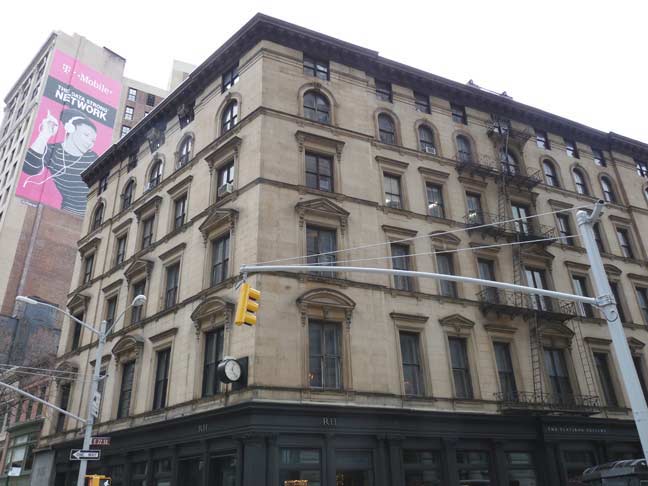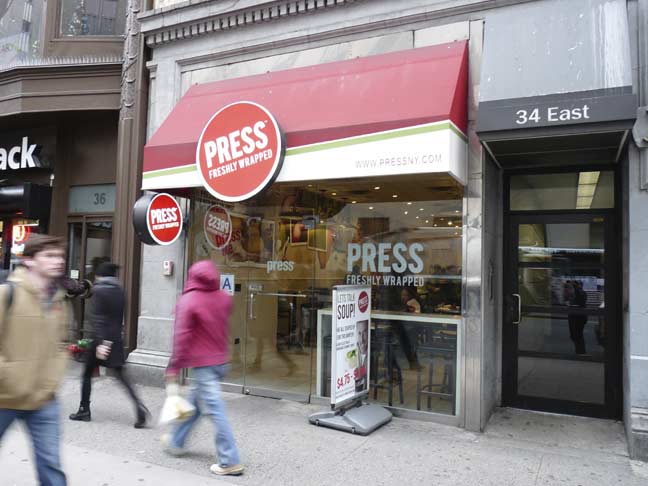I took a walk from Madison Square southeast to Kips Bay and then generally north to the East 34th Street ferry landing in mid- December 2014, before it started getting really cold. I make it a point to walk down one street I have never been on before in NYC once a week (tougher to do that when working) but this trip rather surprised me, since I saw a few things I had never seen before.
I began at Madison Square where I have a slight touch of nostalgia. I worked on the Tiffany & Co. website from their offices for 6 months at 200 5th Avenue and 23rd Street, and my nostalgia stems from the money being that.damn.good. I haven’t approached it before or since! I’ve photographed Madison Square enough for awhile, as it has a collection of statuary depicting William Seward, Roscoe Conkling, Chester Alan Arthur, and other personalities that don’t come to mind when you are thinking of historical figures; as well as, of course, Madison Square’s two remaining antique Twinlamps.

This building faces all of East 22nd between 5th Avenue and Broadway, as well as having lots of frontage on both streets. It’s just north of the Flatiron Building, and it’s about forty years older—it was originally the Glenham Hotel and was finished in 1862. The ground floor is the longtime home of Restoration Hardware (so well known now that the signs just say “RH”, as well as two street clocks on the 5th Avenue and Broadway sides.
According to NY Songlines, this building once housed the saloon of Dr. Jerry Thomas, master mixologist (for whom the Tom and Jerry was named). Cornelius Vanderbilt Jr., son of the Commodore, shot himself here on April 2, 1882, after a night of drinking and gambling.

One of my favorite burrito places, though they don’t call them that, is here at Press on East 23rd and Madison. I reviewed the place as part of my new Eats category in 2014. (I should keep up with that but I haven’t eaten anywhere interesting of late, but reviews should trickle in.)
Returning to East 22nd I found the Ionic-pilastered Steven L. Newman Hall of Baruch College between Park Avenue South and Lexington at #137. The hall was constructed from 1912-1916 as one of the country’s first “Children’s Courts,” established in 1902 and moving to this building in 1915. Prior to the existence of children’s, or family courts, children were charged as adults when accused of wrongdoing. Baruch College acquired the building in 1959.
I had never before known of the existence of Gustavus Adolphus Swedish Lutheran Church a bit further east at #151 East 22nd. The church has occupied this spot since 1866, but constructed this church building in 1887, employing J. Cleveland Cady, the architect of two NYC classics—one demolished and one still standing: The old Metropolitan Opera House at Broadway and West 39th, which disappeared long ago, and a large wing of the American Museum of Natural History at Central Park and West 79th, thankfully still there. The distinctive church is made from gray Amherst Ohio stone.
The cornerstone is distinctive. According to the Daytonian in Manhattan, when the cornerstone was laid a copy of NYC’s Swedish Language newspaper in 1887, as well as a copy of The New-York Times (still with a hyphen then), were placed within. But the exterior is unusual too. The date, 1887, is explainable enough, but the date shown on the left, 1865, is when the church was founded; and on the right, the numbers correspond to a Bible quote from the New Testament 1 Peter 2:6: “See, I lay a stone in Zion, a chosen and precious cornerstone, and the one who trusts in him will never be put to shame.”
The building is also home to The Little Synagogue, Cong. Tel Aviv, founded in 1986.
Meanwhile, I’d like to know the story behind 158 East 22nd, across the street—it’s only two windows across. Curbed had a photo of one of the interiors.
Continuing south and east I found the unusual St. Mary’s Catholic Church of the Byzantine Rite at the SW corner of 2nd Avenue and East 15th, across from Stuyvesant Square. For a lengthy explanation of the religion worshipped here, you can consult, of all places, NYC Architecture.
The building was actually designed by a clergyman, Brother Cajetan J. B. Bauman, and it was completed in 1964. Francis Morrone, in An Architectural Guide to New York City, makes the point that with its large set of stained glass windows, it seems like it was built to light the outside from its sanctuary, rather than allow filtered light to pass within. A pair of large mosaic representations of Mary (and the Disciples) and Jesus complete the picture.
Bait & Hook, seafood restaurant on the NW corner of 2nd Avenue and East 14th Street. Wall art is going to be a frequent theme of this page, since I saw so much of it on this walk. Presumably this mural was commissioned by the restaurant, but to me it reminds me of fish guts. Maybe that was the effect the muralist intended…?
Professor Thom’s is a bar on #219 2nd Avenue between East 13th and 14th Streets. It has a nicely rendered sidewalk sign (the font is reminiscent of Baskerville, but not quite the same). The bar was founded by expatriate New Englanders and is a gathering place for Red Sox, Celtics, Patriots and Bruins fans, who have had a great deal to celebrate the past decade or so. It is across the street from the NY Eye & Ear Infirmary, where the webmaster has had his peepers peeped at in the past.
Sci-fi TV fans will recognize the significance of the numerals painted on the metal rolldown sign.
Establishment at #190 1st Avenue between East 11th and 12th Streets referred to as just “Restaurant” in a sign usually reserved for “privilege” store signs that come with a product name (here, that probably went in the space on the left). Upon looking further, though, I found I had neglected to notice the overhanging illuminated sign proclaiming this as the Tree Bistro. And, Google Street View has been inside.
Arresting new (as of 2015) wall mural at 1st Avenue and East 11th Street.
Someone chalks in the First Amendment on a plywood fence at East 11th and Avenue A. This is a newer version in December 2014, since a Google Street view photo from the same October showed an older version before the fence was painted green.
The windows across the street are obscured by a rollgate, but seen within are odd sculptures and a rusted parking meter head. (Maybe this is one of the ones Luke removed in Cool Hand Luke.) A poster advises that this is the home of Nauketec Media Intergration:
“Nauketec is an association of designers, artists, engineers and fabricators, who, depending on the needs of the project, selectively collaborate to match just the right talents and skills to get the job done — on time and on budget.
If it blinks, moves, makes a sound or tells a story, is made of wood, metal, plastic, or stone, built to be immovable or must travel for years, operated by a crank or lever, or is computer-controlled, where the writing is on the wall, screen, or monitor, let Nauketec quote your next project.”
I can’t help but mention this fire alarm at East 11th and Avenue A—this type was produced only in 1912, evolving from other types of fire alarms that began appearing in NYC streets in 1887. The giveaway is the interlocking FDNY letters. The following year, 1913, saw the FDNY spelled out in four separate letters at the base of the alarm.
Also note that the luminaire shaft is still there; the illustration shows what such a lamp looked like in 1912 when first installed. This relic has now served for over a century!
Sea-themed mural on north side of East 11th between Avenues A and B by artist Lesley Heathcote.
On the south side of the block, at #538-540 East 11th, is one of the many Free Public Baths of New York City, constructed in 1904, an era in which many tenements did not have running water, cold or hot. Note the fish-and-trident theme, which apparently was an emblem of NYC public baths; I have already noted them on the East 54th Street Baths.
From NYC Landmarks Designation Report:
The two-story East 11th Street Bath was situated in a predominantly German neighborhood a block north of Tompkins Square Park and was equipped with seven bathtubs and 94 showers, or “rain baths” as they were known. Reflecting Victorian sensibilities, the men’s and women’s arched entrances were placed on opposite ends of the façade that led to entirely separate waiting rooms and shower rooms. Attendance was greatest in summer months; during the 1906 heat wave, “people stood in lines ‘four deep’” and it soon became apparent that the poor used the baths more as a means of cooling off than for hygienic reasons. Gradually, as bathrooms became standard in apartment buildings public baths were less patronized. Closed in 1958, the building was used as a garage and warehouse until 1995 when Pulitzer Prize-winning photographer Eddie Adams bought and converted it into a high-end fashion and corporate photograph studio.
NY Songlines also reports it was used in the 1982 Ragtime, a film version of the E.L. Doctorow novel.
Nearly directly across the street is the eclectic Father’s Heart Ministry Center at #543-545. It’s one of the oldest buildings on the block, going back to 1868 when this part of town was considered way uptown. The previous year, a resolution was passed by the Methodist Episcopal Church to build a mission here, as the previous one in the region, known as the Dry Dock Mission (so-called for an actual dry dock at East 10th Street and the East River used for ship repairs) shuttered in 1864.
The cornerstone was laid on in October 1867 and construction was completed within three months.The New York Times described the new chapel as “modernized Gothic, adapted to the locality and its internal arrangements.” Composed of red brick, two stories high, the Gothic the handsome, simple building had a lacy, arched corbel table; pointed finials at the corners and center of the roofline; and attractive window hood moldings. —Daytonian in Manhattan
In 1901, the church became the People’s Home Church and Settlement, giving relief to the recent immigrant families on the Lower East Side who were impoverished. “The facility offered industrial classes, lessons in instrumental and vocal music, social clubs, a ‘fresh air program,’ and a reading room.”
The Home Church shuttered in 1930 at the onset of the Depression. The building became home to various churches and ministries; in 1998, the Father’s Heart Ministry Center moved in.
More street art on each side of East 11th on the east side of Avenue B. I’m stuck as to what the “21” signifies, as this isn’t the house number on the corner building at East 11th and Avenue B. The orange art was likely commissioned by the Spina Italian restaurant, on whose 11th Street wall it appears. Recent reports say it is now closed.
If an entranceway is catercorner to an intersection, a decorative pillar is often used to hold up the structure above the entrance in buildings of a certain age. I should get photos of more of these, as they sometimes have different carvings or designs. This one, on the SE corner of East 11th and Avenue, is at the entrance of an office of the local Congresswoman, Nydia Velazquez.
